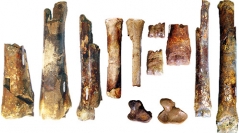

 Geodiversitas
38 (2) - Pages 225-243
Geodiversitas
38 (2) - Pages 225-243The locality Küçükçekmece includes a limited hipparion sample mainly consisting of isolated teeth and some postcranial remains. Using various methods, the teeth and postcranials are separated in two different size groups. The first group, characterized by large size, rich enamel plication, deep and thin plis, double-triple pli caballin, oval protocone with flattened lingual border, absence of lingual hypoconal groove, short and robust metapodials, is related to H. sebastopolitanum Borissiak, 1914 from Sebastopol, Ukraine and it is referred to as H. aff. sebastopolitanum. The second group with very large size, very rich enamel plication, very deep plis, double-multiple pli caballin, oval protocone with flattened lingual border, presence of lingual hypoconal groove, plicated or crenulated flexid’s borders in the lower teeth, short and robust metapodials larger than those of the first form, is closer to H. giganteum Gromova, 1952 from Grebeniki, Ukraine and it is identified here as H. aff. giganteum. Hipparion sebastopolitanum and H. giganteum are known from the Ukrainian early and late Vallesian localities of Sebastopol and Grebeniki, respectively. The similarities of the first form with H. cf. sebastopolitanum from the Vallesian localities Pentalophos 1 and Ravin de la Pluie in Axios Valley (Macedonia, Greece), and of the second form with H. aff. giganteum from the terminal Vallesian locality of Nikiti 1 (Chalkidiki, Greece) support a Vallesian age for the Küçükçekmece fauna; more precisely an age from upper early Vallesian to the end of Vallesian is quite possible. The limited data of the dental and postcranial morphology of the Küçükçekmece hipparions indicate a probable forest and warm/humid environment.
Equidae, Hipparion, late Vallesian, Istanbul region, paleobiogeography